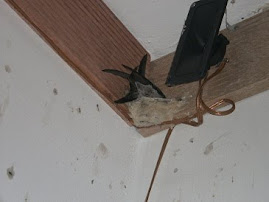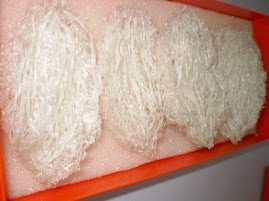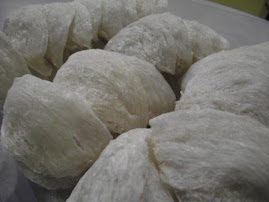谁知杯中窝,盏盏皆辛苦啊!
From source to the pot, birds’ nests take a lot of painstaking and careful effort to produce.
Swiftlet nests which are harvested from caves are naturally nourished with iron and minerals. For those who have a gastronomic liking for birds’ nest, this piece of information may be of interest.
The reddish and yellowish tinge found in birds’ nests is actually a mark of authenticity, according to Dr Charles Leh, zoologist and curator of Natural History at the Sarawak Museum.
“When the nests come in contact with the cave walls they absorb the minerals and this is what makes them red. The cave walls and stones which are enriched with mineral elements such as iron, calcium, magnesium and potassium give the nests their colour,” Dr Leh says.
Last year, there was some uproar about the quality of birds’ nest, during which some processing factories in the country were taken to task for allegedly using dangerous carcinogenic chemicals to give the nests their reddish colour.
Confusion also arose as to which sort of birds’ nest was the real McCoy – the white or red/yellow ones.
“House nests have no mineral elements, therefore they should be white or have a light yellow hue, but never red unless the house was built with rock,” explains Dr Leh.
“This should be an indication of the authenticity of birds’ nests. If a consumer comes across a red house nest, they should know that it is fake.”
Birds’ nests refer to the saliva of a group of small birds known as edible-nests swiftlets. These thumb-sized birds weigh less than 5g. During the breeding season, which takes 45 days, each pair can produce a full nest of saliva, weighing as much as their own body weight.
The saliva is produced from a pair of glands located beneath the bird’s tongue. Both the male and female have a pair of these sublingual glands and contribute towards nest building.
The tri-colour Hua Yan birds’ nest (which contains red, yellow and white nest strands), trademarked by healthcare company and traditional Chinese medicine (TCM) specialist Eu Yan Sang (1959) Sdn Bhd, is considered to be among the top-of-the-line birds’ nest product in the market.
Hua Yan birds’ nest is promoted as having a host of health benefits “such as 16 amino acids, five carbohydrates including EGF, MSF and sialic acid, and minerals”.
 The raw cave nests with their reddish base.
The raw cave nests with their reddish base.
Strict quality control goes into ensuring that the natural nutrients of each Hua Yan birds’ nest is retained before it is put on the shelf.
“The key is finding a supplier who processes birds’ nest the correct way without any chemical bleaching and in the end provides consumers the highest grade of birds’ nest. The craft of processing the nests is actually a key issue as it determines how much of the natural nutrients of the nests are retained after processing,” says Eu Yan Sang general manager Wong Kah Cane.
Kuching, Sarawak, is said to be the major processing centre for birds’ nests. For Eu Yan Sang, the main supplier is Double Swallow Enterprise, a processing factory located in Tapah, a small town about 40 minutes’ drive from Kuching.
Double Swallow Enterprise is owned by the Eng family, namely patriarch Eng Cheng Teng, 68, and his son, Richard. The 1,673sq m processing factory is where skilled workers from the nearby village work for hours to clean the raw birds’ nests, which are harvested from the caves in April, August and December.
“The nests are collected from the Niah and Gomantong caves by the locals. During the harvesting season, we will go there to inspect the quality of the raw nests. We bring back an average of half a tonne per trip. Birds’ nests are worth their weight in gold and there have been some instances in which people were robbed after they collected the nests from the caves,” reveals Richard.
In Kuching, the nests are left to age for about a year to, according to Richard, “strengthen their molecules”.
“During the first collection, each nest should have a reddish base colour with black feathers sticking to it. The amount of feathers also depends on the seasons. The fewer the feathers, the thicker the nest, which is why it is important to collect nests during the right season. The rainy season is best because the birds retain most of their feathers, thus leaving less on the nests. Because of the presence of minerals from the cave walls, the nests will change colour after five or six months,” he says.
The Eng family business has been around for 50 years and was started by Richard’s grandmother, Chew Siew Lan.
“She started the business in Kuching. At that time, the raw nests cost RM200 per kg. Now it is RM2,000 per kg. Currently I help my parents run the business with the help of my nieces and nephews. I also learn a lot about the birds’ nest business from Dr Leh as we often visit the caves together,” says Richard.
The labour that goes into cleaning each nest to make sure it is pure and fit for consumers is intensive. “Of course, it is cheaper and faster to clean them using chemical bleaches but then all the nutrients and proteins would be lost or destroyed. We make sure that our supplier does not use any bleach whatsoever. There is no machinery used and everything is done by hand,” says Wong.
 Each strand is assembled in a mould.
Each strand is assembled in a mould.
Processing raw nests
The nests are first soaked in hot water for 15 minutes to make them softer and to allow them to expand. The trick is not to soak them for too long.
There are 70 to 90 strands per nest. “The value drops if they fall apart so it is important to have good hand skills when working with them,” says Richard.
Next is the tedious process of removing the feathers from the nests. The workers painstakingly do this with sharp tweezers.
“They don’t use gloves to avoid cross-contamination. This is in line with the Good Manufacturing Practice (GMP) standards. Depending on the worker’s skills, each of them ideally needs to clean 1kg of nests per day.”
The nests are hung to dry for two to three hours (depending on the quantity) in a cloth sack to remove excess moisture. They are then kept in a cold room to prevent bacterial contamination. “We don’t re-soak and the temperature has to be perfect so that the nest won’t freeze and spoil,” says Richard.
After this, there is one more round of cleaning to remove any remaining dirt and feathers. “There are no machines involved here. We make sure the staff has good eyesight to pick up the tiniest particles. This is how we take extra precautions to ensure the end product is clean. All the work is done on stainless steel tables so there is no contamination.”
The next round of processing is done in an air-conditioned part of the factory. Before they enter this area, workers stand in a narrow corridor for 30 seconds in front of a blower (to rid themselves of dust) before they each don shoes, gloves, a vest and a hairnet. Such procedure conforms to the GMP standards.
Their work is to arrange the clean, luminous strands of nests into moulds. Thicker strands are placed on the bottom, followed by thin ones on the sides. The worker has to ensure that the strands do not break and to throw away the bad ones.
“Many of our customers complain when they see broken strands in the package. The average weight of each piece is controlled by the size of the mould,” says Wong.
 Tedious process: Removing the feathers from a nest is a painstaking process.
Tedious process: Removing the feathers from a nest is a painstaking process.
Next, the mould is removed and the nests are placed on a steel tray with a wire mesh for another process of drying. This is done in a temperature-controlled drying room where the air movement is also controlled. After a few hours, the nests are packed in plastic boxes and shipped to Eu Yan Sang where they are re-packed with the company’s packaging.
“At Eu Yan Sang, we sell the birds’ nests according to pieces instead of weight because after some time, they become lighter. At that point they can easily break and must be handled with care. This is why we trust and maintain a good relationship with the Eng family as our supplier because we know how they operate,” Wong says.
Eu Yan Sang was founded in 1879 by Eu Kong, a migrant Chinese from Foshan, Guandong. It started in Gopeng, when Eu Kong noticed that the local tin miners widely used opium as a means to ease their daily pains and ill-health.
He began to dispense Chinese herbal remedies as substitute to opium. This set the stage for the Eu Yan Sang story.
“Yan” in Chinese means benevolent, kind or humane. “Sang” is birth, life or livelihood. Together, it means “Caring for Mankind”.
Tips on cooking bird's nest
Birds nest is best boiled and consumed with simple rock sugar.
> Dip the nest in water for at least 10 minutes to remove any dust on the surface. For the Hua Yan nest, it is best to soak it for at least two hours. The red-coloured nest should be soaked overnight. When ready, the nest should be fully expanded and soft to the touch. If it’s possible, use filtered or cool boiled water for soaking the nest.
> Do not throw out the water used to soak the nests. Pour it into a double-boiler pot with the nest and cook for two-and-a-half to three hours. Then add rock sugar according to your personal taste. (For home nests, boiling should not exceed 40 minutes, otherwise the nest will completely dissolve.)
The use of a double-boil pot is to avoid direct heating and a piece of cloth should always be placed beneath the top pot. Using boiled water and steam to “cook” the bird’s nest ensures that heat is regulated (less than 100°C) to preserve the nutritional goodness of the nests.
> Turn off the heat. Do not open the lid yet. Let the contents cool for 30 minutes. The liquid should be smooth and clear.
Source : The Star 9th Jan 2011. "Building bird's nests" by Aida Ahmad


















































